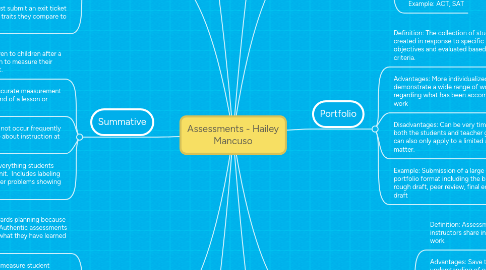Assessments - Hailey Mancuso
par Hailey Mancuso


1. Diagnostic
1.1. Definition: Gathering and evaluation of detailed data using students' knowledge and skills in a given learning area.
1.2. Advantages: helps teachers plan for appropriate, targeted learning to more effectively scaffold learning needs
1.3. Disadvantages: Might be designed blindly if it comes before a lesson or unit, can be timely and extensive
1.4. Example: Hold a conference/interview with students before a unit to hear what they know about the topic
2. Authentic
2.1. Definition: Sometimes considered backwards planning because these assessments drive the curriculum. Authentic assessments often ask students to analyze and apply what they have learned through performance
2.2. Advantages: Authentic assessments measure student performance, rather than knowledge. They judge the actual implementation of ideas rather than rote memorization of facts
2.3. Disadvantages: Since it is not considered traditional, it could be difficult to always find a real world application for students to be assessed. For example, in a spelling test, traditional methods are usually the only way to determine if the student knows how to spell.
2.4. Example: To show proficiency in sentence structure, students are asked to rearrange a jumbled paragraph so that it makes sense semantically and grammatically.
3. Performance Based
3.1. Definition: Performance-based assessments helps answer the question, “How well can you use what you know?” This is showing how students actually apply their knowledge.
3.2. Advantages: Going beyond something like a multiple choice test, students can actually show what they know and won't be able to get away with guessing.
3.3. Disadvantages: Can be difficult to implement in a large class setting compared to a standard format for assessment.
3.4. Example: Ask students to write a short story containing fable elements rather than quizzing them on what the elements are.
4. Formative
4.1. Definition: A formative assessment is embedded within instruction, meaning it is given during instruction. Can be used to determine what needs or topics have to be addressed next with a student.
4.1.1. Project specifications
4.1.2. End User requirements
4.1.3. Action points sign-off
4.2. Advantages: Can be an interactive process with the students, can provide timely feedback, less formal, very directional
4.3. Disadvantages: Students might not always try their best when they don't feel pressured to, which can make it hard to tell their actual strengths/weaknesses
4.4. Example: Students must submit an exit ticket describing 3 character traits they compare to themself
5. Summative
5.1. Definition: Assessment given to children after a specific point in instruction to measure their understanding of a subject.
5.2. Advantages: Provides an accurate measurement of student learning at the end of a lesson or unit
5.3. Disadvantages: These do not occur frequently enough to be informative about instruction at the classroom level
5.4. Example: A quiz covering everything students learned in their geometry unit. Includes labeling shapes and solving perimeter problems showing work.
6. High Stakes
6.1. Definition: A test with important consequences for the tester. This can lead to getting accepted into colleges, passing benchmarks, etc.
6.1.1. Materials
6.1.2. Personel
6.1.3. Services
6.1.4. Duration
6.2. Advantages: These tests can show the differences and gaps of learning among students. These can often easily divide students between above level, at level, or below level.
6.3. Disadvantages: These tests might not show a true measure of what students know. They might know and be able to perform tasks but not do well when under pressure test taking.
6.4. Example: ACT, SAT
7. Portfolio
7.1. Definition: The collection of student work created in response to specific instructional objectives and evaluated based on the same criteria.
7.1.1. Dependencies
7.1.2. Milestones
7.2. Advantages: More individualized way of assessing students, may demonstrate a wide range of work, encourage goal setting regarding what has been accomplished and what needs further work
7.3. Disadvantages: Can be very time consuming for both the students and teacher grading them. These can also only apply to a limited amount of subject matter.
7.3.1. Schedule
7.3.2. Budget
7.4. Example: Submission of a large essay in a portfolio format including the brainstorming, rough draft, peer review, final edits, and final draft
7.4.1. KPI's
